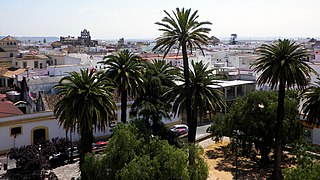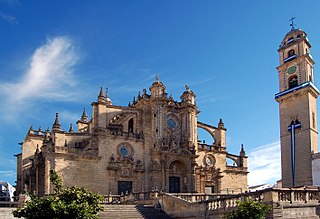
Ejea de los Caballeros, commonly known simply as Ejea, is a town and municipality in the province of Zaragoza, part of the autonomous community of Aragon, Spain. It is one of the five main towns in the Comarca de las Cinco Villas, along with Sos del Rey Católico, Uncastillo, Sádaba, and Tauste.

Cádiz is a province of southern Spain, in the southwestern part of the autonomous community of Andalusia. It is the southernmost part of mainland Spain, as well as the southernmost part of continental Europe.

The province of Badajoz is a province of western Spain located in the autonomous community of Extremadura. It was formed in 1833. It is bordered by the provinces of Cáceres in the north, Toledo, Ciudad Real in the east, Córdoba in the south-east, Seville, and Huelva in the south and Portugal in the west.

Jerez de la Frontera or simply Jerez, also cited in old English-language sources as Xeres, is a city and municipality in the province of Cádiz in the autonomous community of Andalusia, Spain. Located in southwestern Iberia, it lies on the Campiña de Jerez, an inland low-land plain crossed by the Guadalete river, midway the Atlantic Ocean, the Guadalquivir river and the western reaches of the Subbaetic System.

In Spain, a comarca is either a traditional territorial division without any formal basis, or a group of municipalities, legally defined by an autonomous community for the purpose of providing common local government services. In English, a comarca is equivalent to a district, county, area or zone.

Antequera is a city and municipality in the Comarca de Antequera, province of Málaga, part of the Spanish autonomous community of Andalusia. It is known as "the heart of Andalusia" because of its central location among Málaga, Granada, Córdoba, and Seville. The Antequera Dolmens Site is a UNESCO World Heritage site.

El Puerto de Santa María, locally known as El Puerto and historically in English as Port Saint Mary, is a municipality of Spain located on the banks of the Guadalete River in the province of Cádiz, Andalusia. As of 2016, the city has a population of c. 88,184, of which some 50,000 live in the urban center, and the remainder in the surrounding areas.

Arcos de la Frontera is a town and municipality in the Sierra de Cádiz comarca, province of Cádiz, in Andalusia, Spain. It is located on the northern, western and southern banks of the Guadalete river, which flows around three sides of the city under towering vertical cliffs, to Jerez and on to the Bay of Cádiz. The town commands a fine vista atop a sandstone ridge, from which the peak of San Cristóbal and the Guadalete Valley can be seen. The town gained its name by being the frontier of Spain's 13th-century battle with the Moors.

The Visigoths entered Hispania in 415 and they rose to be the dominant people there until the Umayyad conquest of Hispania of 711 brought their kingdom to an end.

Alcalá del Valle is a city located in the province of Cádiz, Spain. According to the 2006 census, the city has a population of 5,355.
Jérez del Marquesado is a municipality in the province of Granada, southern Spain. It borders the municipalities of Cogollos de Guadix, Albuñán, Valle del Zalabí, Alquife, Lanteira, Bérchules, Trevélez, Güéjar Sierra and Lugros.

Campiña de Jerez is a comarca in the province of Cádiz, southern Spain.
Spain has many coats of arms: the nation has one, the reigning monarch and the heir presumptive each have one, and there are others for the institutions of state and for Spanish regions and towns.

The Diocese of Jerez de la Frontera is a Latin Church diocese of the Roman Catholic Church. Its name derives from the localities of Medina-Sidonia and Jerez de la Frontera. This bishopric was erected the 3 of March 1980 by means of a Papal Bull, with the name of Asidonense-Jerezano, in memory of the old Asidonense Bishopric and because its present seat is in Jerez de la Frontera. The main temple of this diocese the Colegiata of San Salvador, today Jerez's Cathedral. The Bishopric of the Diocese is in Palace of Bertemati, in the Seat of the Stream. Asidonia-Jerez Seminary was founded in 1985.

Fregenal de la Sierra is a municipality located in the province of Badajoz, Extremadura, Spain.

Villanueva del Fresno is a town in Badajoz Province in Extremadura, Spain.

Campiña Sur is an administrative division (comarca) in the province of Badajoz, Extremadura, Spain. Its capital and administrative center is the municipality of Llerena. It contains 21 municipalities and 32,841 inhabitants in an area of 2,798 square kilometres (1,080 sq mi).





















